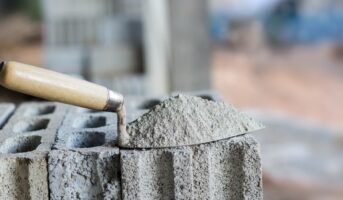Stone masonry is an old technique used from ancient times. It has been used to build structures like temples, houses, walls, and so on, which are still standing today. The process of construction involves the use of stone and mortar. In this article, we will explore more about stone masonry and its types.
Stone masonry: What is it?

Source: Pinterest
Stone masonry refers to the process of construction using stones by affixing them to one another with mortar. After being honed and smoothed into the desired form, stones that occur naturally in large quantities can be utilised as a cost-effective building material for designing various architectural elements, including but not limited to facades, columns, arches, and beams, among other things.
Compared to brick masonry, stone masonry is preferred for building piers, docks, dams, lighthouses, and other maritime structures due to its greater strength, durability, and resistance to the effects of weather.
know about: ashlar masonry
Stone masonry: Materials necessary

Source: Pinterest
The following are examples of materials that are used in stone masonry, both of which play a significant part in the overall structure’s ability to sustain the load.
-
Stones
Stones that will be utilised in stone construction ought to be robust, long-lasting, and hard, and they can’t have any cavities, sand holes, or fractures in them. The stones must be chosen with consideration given to the accessibility of stones and the significance of construction. Limestone, granite, sandstone, marble, and laterite are only a few of the stones that are often used in construction.
-
Mortar
In this kind of brickwork, the most frequent mortar ingredients are cement and lime. The strength that is necessary, the pigment of the stone, and the loads that are emanating from the structure all have a role in the choosing of the mortar.
Stone masonry: Considerations
While overseeing the stone masonry work, the following aspects must be considered.
- Stone masonry is often constructed with either cement or lime mortar. Above the plinth level, mud may be employed as a binding agent.
- The stone should be processed such that when it is erected in a structure or arch, the force exerted on it is perpendicular to the direction in which it was lying on its underlying quarry bed.
- It is preferable to design walls without any visible vertical joints. Joints in the vertical direction should not overlap in any two successive layers. By adhering to this idea, you can be sure that your wall’s stones will form a solid connection that will allow it to withstand the force you apply.
- Headers or through stones are used to connect the wall’s foundation and outside. In a wall, they should be spaced in successive levels to ensure that they are uniformly distributed throughout the whole surface. Headers along the same path should not be more than three to four feet apart.
- Always remember that the quality of ashlar masonry depends on the hardness and treatment of the stones. In contrast, the excellence of rubble masonry depends on the strength of the mortar and the homogeneity of the interior filling of the walls or the quality of the workmanship in general.
- After the mortar has been applied, the stonework should be kept moist for a few days so it can set and solidify. There is a 15- to 21-day window for curing.
- All reasonable efforts should be made to distribute the load along the axial and central axes of the masonry components. For masonry to function well under non-axial, asymmetrical, or angular loads, extra care must be taken to prevent the development of tensile strains in any area of the structure.
Recommendations regarding stone type
| S.No. | Purpose | Utilisable Stone Type |
| 1 | Substantial Engineering structures, such as dams, seawalls, bridges, piers, etc., are subject to tremendous pressure. | Granulated granite and gneiss. |
| 2 | Masonry works in a factory environment with smoke and chemicals. | Granite, quartzite and compact sandstone. |
| 3 | Construction in general | Limestone and sandstone |
| 4 | Architectural cladding | Closed-grained sandstone, marble, and granite. |
| 5 | Carvings and other forms of decorative work | Soft sandstone, marble, and laterite |
| 6 | Floors, thresholds, and stairways | Slate, sandstone, marble |
| 7 | Masonry that resists flames | Compact stone. |
Stone masonry: Types
Stone masonry may be broken down into two primary categories, the first of which is determined by how the stones are laid out in the structure, and the second is determined by the level of polish present on the surface.
-
Ashlar Masonry

Source: Pinterest
This type of stone masonry often makes use of stone blocks that are either square or rectangular in shape. Some of the courses are lower than others. Between 250 and 300 mm is the height of the stones. Because of its high cost, ashlar masonry is often only used for the outside face of a wall, with cheaper brick rubble utilised for the inner and middle layers.
Many different types of dressing are used to smooth the surface of ashlar masonry, although they may be broken down into the following broad categories:
-
Rough-Tooled Ashlars
Stones used in rough-tooled ashlar masonry have had their sides cut to a precise form and angle before being used to construct the structure. The surface of the stones, on the other hand, is left with a somewhat rough texture and is only minimally chiselled and smoothed with a hammer or chisel.
The outside of the wall will have a weathered appearance as a result of this, but the inside will be sturdy and simple to construct due to the fact that the stones have already been cut and moulded more easily fit together.
-
Rock-Faced Ashlars
In Rock-faced ashlar masonry, the edges of the rock are highly processed to give it a certain form, but the face of the block is left unprocessed, raw, and is generally left intact from the quarry.
In contrast to rough-tooled ashlar masonry, the stone faces of rock-faced ashlar masonry are left entirely unaltered. This results in a more textured appearance on the outside of it.
-
Chamfered Ashlars
One of the most sophisticated approaches to stonemasonry is called chamfered ashlar. Stones are worked over carefully to make consistent blocks of stone.
Additionally, the faces are treated to provide a more consistent texture, and after that, a little bevel is placed all the way around the face of the stone. This results in a highly sophisticated appearance that is reminiscent of conventional brickwork.
-
Block in Course Masonry
The two types of masonry, rubble and ashlar, are combined to create a block in course masonry. The wall’s face is constructed out of ashlar stones, which are stones that have been carved to a certain form. The rubble masonry construction method is also used to construct the remaining portion of the wall’s structure that is located behind the face.
By using this method, you are able to enjoy the benefits of two distinct types of masonry: the low-cost materials of rubble masonry and then the more sophisticated appearance of ashlar masonry face.
-
Ashlar Facing
The prior method and the ashlar facing approach are extremely comparable to one another. Bricks, not rubble masonry, make up the bulk of the wall’s construction; ashlar facing functions similarly to a facade on the wall’s outside, giving it the appearance of being made of stone. The appearance of the stone is achieved by this method.
-
Fine-Tooled Masonry
Stones that are used in fine-tooled masonry are cut very precisely to the desired dimensions and contours of the final piece. Due to the fact that they interlock so perfectly, the mortar joints may be as shallow as only 2-3 millimetres (about 1/8 of an inch).
This form of the wall might be more costly than others due to the additional time that masons will need to spend carefully cutting and fitting the rocks, but the final result is a wall that is very sturdy and elegant.
-
Random Course Ashlars
You may place stones haphazardly without producing consistent mortar joints, despite the fact that it is typical to arrange stones in a manner that generates joints that are defined vertically and horizontally. This is a great design for producing an elegant and little rustic appearance all at the same time.
-
Rubble Masonry

Source: Pinterest
In rubble masonry, stones of varied sizes are used to create the structure. It is possible for it to have an uneven face, which would generate uncoursed and random debris, or it might have a rectangular face, which would produce course rubble. The following is a list of the several varieties of rubble masonry:
-
Coursed Rubble Masonry
This is the simplest and cheapest method of constructing a stone wall. In this kind of rubble construction, the stones used might be any size between 50 and 200 mm. This kind of stone masonry is often used in schools and hospitals, churches, and homes.
-
Uncoursed Rubble Masonry
In this type of rubble masonry, the stones are not treated in any way. They are put to use without any modifications, with the exception of having some of the corners knocked off. The low cost of this kind of rubble masonry makes it a popular choice for the construction of composite walls, warehouses, and garages.
-
Random Rubble Masonry
This kind of stonework makes use of stones that range in both size and shape. The stones are laid down in a design that is aesthetically attractive. This kind of masonry may be used to construct residential structures, complex walls, and godowns, among other things.
-
Dry Rubble Masonry
Similar to coursed rubble masonry, the only difference in the building process is the absence of mortar in the joints of this kind of rubble masonry. Several examples of possible uses include composite walls, slope protection, and bridge approach ramps.
Stone masonry: Advantages
Stone masonry offers a range of advantages, which is one of the reasons why it is used for a variety of building projects. The following is a list of some of the most significant ones.
-
Strength
Incorporating stones into the building process ensures a sturdy structure once completed. When compared to other materials, stone’s typical compressive strength of roughly 104.9 MPa makes it a superior choice. Simply said, compressive strength is the greatest force under which the stone will not break or shatter.
-
Weather Resistance
The four seasons each provide their own unique set of challenges for buildings. Therefore, this is a crucial factor to think about. Stone masonry is impervious to the corrosive effects of rain, hail, and snow, among other weather conditions. Since stone can not retain moisture during precipitation, there won’t be any mould or rot issues later on.
-
Durability
Masonry built with stone benefits greatly from the material’s resistance to wearing, pressure, and destruction compared to other building materials and processes. It can withstand a lot of stress before breaking, and it’s tough enough that it won’t bend, warp, fracture, deform, or swell.
-
Design Possibilities
Stone Masonry is superior to other techniques because of the sophisticated appearance it may achieve. Stones may be found in many different shapes, sizes, and even tints. As a result, the number of potential layouts is almost limitless. Stone’s adaptability also means that it may be used in combination with a wide variety of building materials. You may achieve an air of grandeur and imposingness with its help.
-
Maintenance
Stone masonry structures are very low-maintenance in comparison to those built using other technologies like brick masonry, which requires frequent plastering and colouring wash.
Stone masonry: Disadvantages
Although there are several benefits to stone masonry, there are also a few disadvantages including the following.
-
Weight
The walls that are constructed using stones are substantial due to their weight. This is a negative aspect since it results in a reduction in floor space.
-
Require Skilled Workers
Because this building method requires a great deal of caution and attention to detail, the workers who carry it out need to be highly competent. This is due to the fact that there is very little space for error, meaning that adjustments, fixes, or even resettlement cannot be accomplished readily after the structure has been constructed. Installation must also be performed with caution in order to ensure the homeowners’ safety.
-
Handling
Handling these components may be difficult because of the stones’ thickness and weight, and this makes it more likely that accidents will take place. Therefore, more caution is required to ensure the safety of both the individuals working on the project as well as the materials and equipment that is being used.
-
Construction Cost
Stone masonry tends to have construction prices that are on the upper end of the spectrum because of the high demand for trained labour, the high cost of the appropriate tools, and the numerous additional expenditures that are spent.
-
Transportation
Because stones are often located in certain locations, such as quarries, it is required to transport them to the construction sites where they will be used. The heaviness of the stones results in a consequent increase in the expense of this.
-
Time Consuming
Time is a major factor throughout the entirety of the building process. One reason for the delay is the need for extreme care while moving the stones. Then there’s the construction, which will be slower than other approaches.
Transform your outdoor space with custom stone masonry
Stone wall cladding is a popular trend for exterior home designs. choose natural materials such as sandstone, limestone, slate and marble to design exterior walls. This brings a rustic and earthy appeal to the outdoor area. Besides, the design helps in enhancing thermal performance of the building and protecting it from outside elements.
Stone masonry: The ancient craft still relevant today
Stonemasonry is a traditional, manual craft existed since the time of early humans used fashion tools and constructed domestic dwellings, structures, and everyday artefacts. Examples of ancient stonemasonry is the Stonehenge, Taj Mahal, and Pyramids of Giza. The construction required quarrymen extracting rock from earth and sawyers cutting out slabs that were further carved by the masons.
FAQs
What are the prerequisites for a quality stone?
Good construction stones should have a specific gravity of between 2.4% and 8%. Rainwater, which is often acidic, may erode a stone if it is porous.
What factors distinguish stone masonry?
Stones used for masonry construction must meet strict requirements for hardness, toughness, and durability. The stone must be prepared to specification. It is not acceptable to have dumbbell-shaped headers or bond stones. It has to have a low absorption rate for water.
Where is stonework employed?
Stone masonry refers to a specific subset of masonry building techniques that use stones and mortar. This method is used while constructing footings, flooring, retaining structures, spans, facades, and columns. Stones used in masonry work are all-natural stones.
What is the difference between stone masonry and brick masonry?
Stone masonry involves using individual stones to build structures, while brick masonry involves using manufactured bricks. Stone masonry tends to be more expensive and time-consuming than brick masonry, but it offers a more unique and natural appearance.
What are some famous examples of stone masonry?
Some famous examples of stone masonry include the pyramids of Giza in Egypt, the Taj Mahal in India, and the Colosseum in Rome.
What is dry stone masonry?
Dry stone masonry is a technique that involves building structures without using mortar. Instead, stones are carefully selected and arranged to fit together tightly, forming a strong and stable structure.
Housing News Desk is the news desk of leading online real estate portal, Housing.com. Housing News Desk focuses on a variety of topics such as real estate laws, taxes, current news, property trends, home loans, rentals, décor, green homes, home improvement, etc. The main objective of the news desk, is to cover the real estate sector from the perspective of providing information that is useful to the end-user.
Facebook: https://www.facebook.com/housing.com/
Twitter: https://twitter.com/Housing
Email: [email protected]











